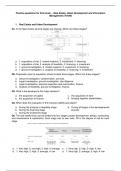Practice questions for final exam – Real Estate, Urban Development and Information
Management (7U4X0)
1. Real Estate and Urban Development
Q1. In the figure below several stages are missing. Which are these stages?
a. 1. acquisition of site, 2. market research, 3. investment, 4. financing
b. 1. acquisition of site, 2. analysis of feasibility, 3. financing, 4. investment
c. 1. ground investigation, 2. market research, 3. investment, 4. financing
d. 1. ground investigation, 2. analysis of feasibility, 3. financing, 4. Investment
Q2. Preparation prior to acquisition should include three stages. Which are these stages?
a. Ground investigation, contamination, services.
b. Legal investigation, ground investigation, due diligence.
c. Legal investigation, physical inspection and examination, finance.
d. Analysis of feasibility, ground investigation, finance.
Q3. What is the developer’s first major decision?
a. the acquisition of capital c. the acquisition of land
b. the acquisition of finance d. bringing together stakeholders
Q4. When does the evaluation of the financial viability take place?
a. During the analysis or feasibility stage d. During all stages of the developmental
b. During the financing stage process
c. During the investment stage
Q5. The real estate chain can be divided into four stages: project development, design, contracting,
and maintenance & exploitation. Each stage has its own risks. Fill in the degree of risk for each
stage.
a. 1: Very high, 2: very high, 3: high, 4: average c. 1: Very high, 2: high, 3: high, 4: low
b. 1: Very high, 2: high, 3: average, 4: low d. 1: Very high, 2: average, 3: high, 4: low
, Q6. Within the investment market, valuation will take place, using the Gross Initial Yield. If the gross
rental income is €100.000 and the total investment is €2.000.000, what is the Gross Initial Yield?
a. 20% c. 6%
b. 8% d. 5%
Q7. Which of the following statements is TRUE?
a. Frictional vacancy is vacancy directly after completion or renovation of a building
b. Frictional vacancy is vacancy caused by the movement of users
c. Frictional vacancy is vacancy caused by too high rents
d. Frictional vacancy is vacancy that lasts longer than 3 years
Q8. DiPasquale and Wheaton developed a conceptual framework to explain the coherence between
the market for real estate space and real estate assets. Which four markets are integrated within
this model?
a. Space market, Asset market, Construction market, Stock adjustment market
b. User market, Investment market, Space market, Construction market
c. User market, Investment market, Construction market, Stock adjustment market
d. Space market, Investment market, Construction market, Asset market
Q9. If you want to develop a property. What is the first step to take?
a. Decide on the type of application you need and request an application form.
b. Submit your application with the correct fee and necessary supporting documents
c. Contact the planning department within the local planning authority for advice
d. Publicize your plan, in order to inform possible stakeholders
Q10. The decision on the form of the contract will depend on the developer’s requirements and the
size and complexity of the development. Time, cost and performance will be the key influencing
factors. Different types of developers/stakeholders will attach varying degrees of importance to time,
costs and performance. Which of the criteria will be prioritized the highest by an investor?
a. Performance c. Cost
b. Time d. Both, cost and performance
Q11. Reed and Sims distinguish several stages within the property development process. What
sequence of stages is typical for a speculative development? Put the stages in the right order: 1.
Acquisition 2. Commitment 3. Consent and permission 4. Design and costing 5. Implementation 6.
Initiation 7. Investigation and analysis of viability 8. Leasing/managing/disposal
a. 6-1-5-7-8-4-3-2 c. 6-1-5-7-4-3-2-8
b. 6-7-1-4-3-2-5-8 d. 6-7-1-8-2-4-3-5
Q12. In each stage of the property development process there are a variety of stakeholders. Some
stakeholders will be involved in more than one stage or will remain involved for the entire
development process. One of the stakeholders mentioned by Reed and Sims is the ‘professional
team’. Which of the following professionals belong to the ‘professional team’ normally?
a. Landowners, developers, planning consultants, market research analysts/valuation
surveyors, architects, quantity surveyors, accountants.
b. Planning consultants, market research analysts/valuation surveyors, architects, quantity
surveyors, engineers, project managers, solicitors, accountants.
c. Planning consultants, architects, quantity surveyors, engineers, project managers, real
estate agents, solicitors, accountants.
d. Landowners, developers, public sector and government agencies, planners, financial
institutions and lenders and building contractors.




